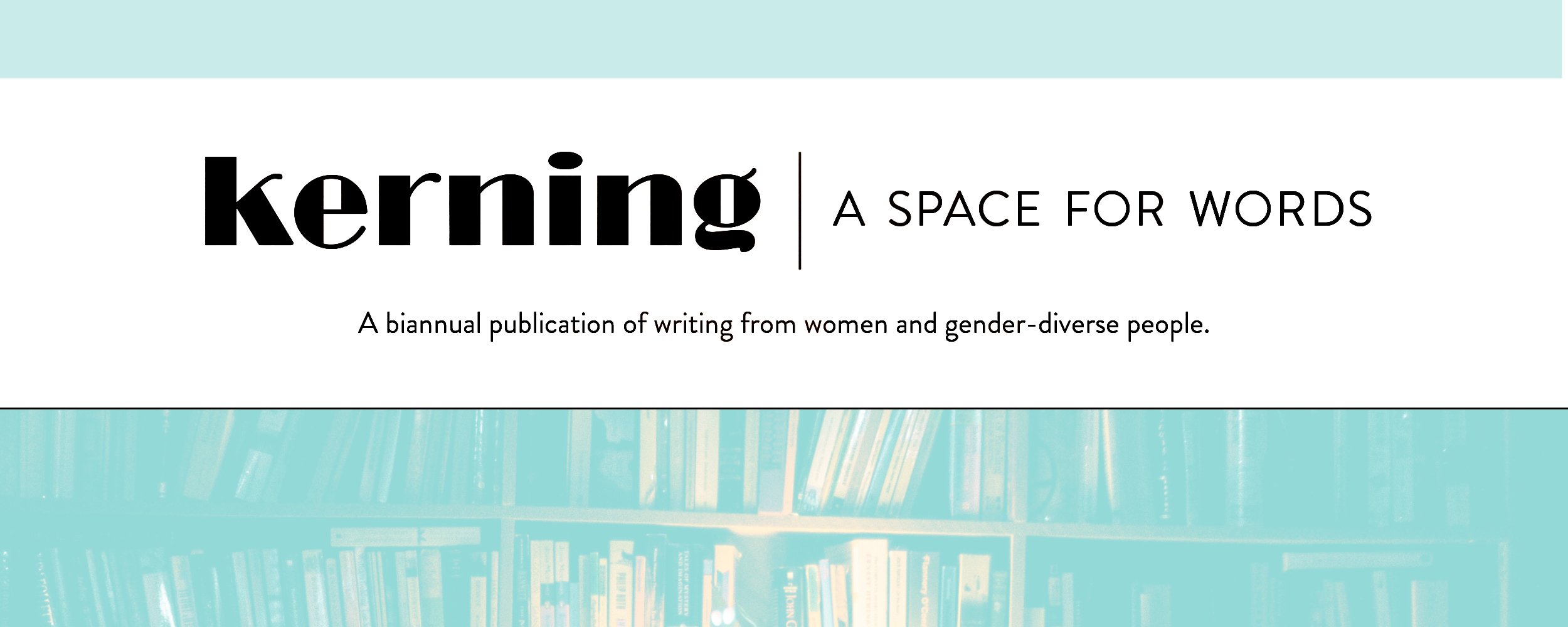kerning is currently on hiatus. Back issues are still available, see them all below.
kerning no. 5
The Company We Keep
“Each friend represents a world in us, a world possibly not born until they arrive, and it is only by this meeting that a new world is born.” – Anaïs Nin
This fifth issue of kerning features writing that explores kinship and connection with another—whether longstanding or fleeting, platonic or romantic, familial or foreign, bewildering or obvious, carefree or complicated. What was the magnetic force that drew two people into orbit with each other (or flung them out of it?), and what world was born from their tether to each other?
kerning no. 4
Body as Evidence
“In a perverse way, I was glad for the stitches... that there would be scars. What was the point in just being hurt on the inside? It should bloody well show.” ―Janet Fitch
In this fourth issue of kerning, the writing tackles visibility and the body, and the journeys of discovery, healing, and even destruction that are undertaken to lay the truth bare. What stories do our bodies hold and which do they (try to) release? What experiences leave a mark on our bodies and why? What does the body know that we don’t? And how does our relationship with our bodies impact the stories we tell about them or about ourselves?
Secret Identities
kerning no. 3
“...I think we are well-advised to keep on nodding terms with the people we used to be, whether we find them attractive company or not. Otherwise they turn up unannounced and surprise us, come hammering on the mind's door at 4 a.m. of a bad night and demand to know who deserted them, who betrayed them, who is going to make amends.” —Joan Didion, Slouching Towards Bethlehem
For the third issue, we invited writers and artists to send us work based on the theme “Secret Identities,” writing that delves into what we conceal, obstruct, or obscure from view—whether it's by necessity, choice, or circumstance—and whether we're hiding from ourselves or the world.
kerning no. 2
It’s All Relative
In the second issue of kerning, we asked for work that incorporates the paradox of comparison and connection when we say: It’s All Relative. This issue includes stories about actual families or relationships, or pieces about situations or experiences that resist comparison or attachment, stories in which one’s decisions, behavior, mindset, or action flouts another’s expectations or understanding.
Taking a Leap
kerning no. 1
The debut issue of kerning focused on the theme “Taking a Leap.”
Writers told us about intersections that call us (and sometimes demand us) to choose one direction over another and further, what informs these decisions—comfort or curiosity? Fear or courage? Clarity or recklessness? Loyalty or rebellion?
The pieces in this issue explore a moment that brought the writer to the edge of opting in or out of a choice, the narratives that unfolded as a result of their decision, and what happened when they left their familiar landscapes in favor of the unknown.
SOLD OUT
Kerning’s Origin Story
When we were first putting together our ideas for the Toad Hall Editions literary journal, we named it Messing About in Boats. When we were already deep in to the details we were alerted to the fact that a publication called “Messing About in Boats” already existed. It’s a boating magazine that has been in print since 1983, which meant we needed to make an adjustment, change direction, and rename our forthcoming bi-annual journal.
“Messing about in boats” is a phrase from Kenneth Grahame’s book “The Wind in the Willows”, which is the inspiration for both the name of our house in Maine and our new small press. After spending time combing his text for other options, we realized we didn’t need to marry ourselves to the book, but might expand our search. But where? To what?
Then Maya woke up one morning and said a new title had come to her during the night: kerning.
In typographical parlance, kerning is the space between two letters, an often-unnoticed adjustment made by designers to connect the letters, which in turn helps with our understanding of a word. Kerning is the unseen in everything, it’s the liminal space. And since we’ve said we want to publish the work of writers whose work lives in this particular space, it feels perfect.
The word liminal comes from the Latin. Its root is limen, which means threshold. So the liminal space is the space between here and there—the transition space between something we have left behind and where we might end up. It’s a space full of curiosity and possibility. It’s the space where we make adjustments to further our connections, where we leave room for vulnerability and trust. It’s our opportunity for kerning. And so we’ve made a shift, adjusted our plans, and we’re thrilled to share the new title of our bi-annual publication is:
kerning | a space for words






